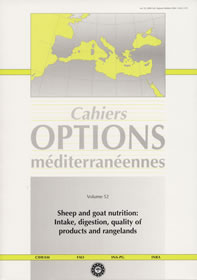| Article précédent | p. 165-169 | Article suivant |
Creating aversion to toxic plants in ewe lambs: The example of Ferula communis
The circum-Mediterranean perennial Ferula communis contains anticoagulant constituents. Conditioned feed aversion (CFA) consists of building up temporal contiguity between ingestion of the plant and post-ingestive malaise in order to elicit rejection at later encounters. Because most casualties are ewe-lambs, within 30 days of being turned out, the first objective was to achieve CFA for 30 days. In experiment 1, six weaned which had been accustomed to F. communis for 1 week, were averted to F. communis by administrating orally two doses of 266 mg LiCl kg -1 BW at 5-day intervals at the time of F. communis meals. Six lambs served as unaverted controls. The aversion persisted for 31 days. The lambs were then turned out to pasture on a F. communis-infested artificially-constructed paddock. Averted lambs consumed 28 per cent less F. communis. Lambs consumed more F. communis, and CFA was more effective, when pasture standing biomass was low (1,060 kg DM ha-1), compared with medium (2,070 kg DM ha-1).
- [ Afficher ]
- [ Télécharger ]
- [ Exporter la citation ]
Vous pouvez télécharger la citation au format :
- [ Imprimer ]
-
Mots-clés
FERULA COMMUNIS, OVIN, PLANTE TOXIQUECiter cet article
Landau S., Perevolotsky A., Egber A., Shlosberg A., Belaich M. Creating aversion to toxic plants in ewe lambs: The example of Ferula communis. In : Ledin I. (ed.), Morand-Fehr P. (ed.). Sheep and goat nutrition: Intake, digestion, quality of products and rangelands. Zaragoza : CIHEAM, 2000. p. 165-169. (Cahiers Options Méditerranéennes; n. 52). 8. Seminar of the Sub-Network on Nutrition of the FAO-CIHEAM Inter-Regional Cooperative Research and Development Network on Sheep and Goats, 1998/09/03-05, Grignon (France). http://om.ciheam.org/om/pdf/c52/00600331.pdf



